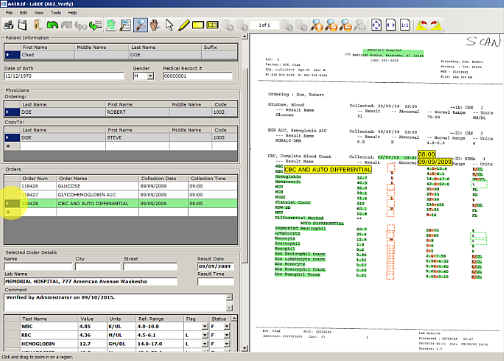In my previous post, the fifth in a series of seven blog posts that discuss some misperceptions about lab interfaces and intelligent clinical data extraction software, I addressed the belief that if a hospital has an in-house laboratory that all test results will be integrated with the patient record in the EMR.
Read MorePosted by Greg Gies on Nov 11, 2015 12:06:00 PM
Posted by Dr. John Daller, MD, PhD, FACS on Nov 9, 2015 1:57:00 PM
Transplant Evaluation Process Part 3 in a 6 part blog series
Once the transplant evaluation visit has been completed, the required testing and other consults that were ordered or deemed necessary need to be completed. Frequently, this is the most time consuming segment of the evaluation process and where automation can be most useful. First, all the tests and visits must be scheduled. If the program does not facilitate the scheduling process considerable time can be added to the evaluation process. Having block time for common tests such as ultrasounds and cardiac echocardiograms can provide ease of scheduling and access and result in shorter evaluation times. Doing this often permits closer working relationships with the program's consultants which enhances the quality of the consults received and patient experience. During this time, the patient will also have any multi-disciplinary team assessments that were not completed during the evaluation as well as any other specialist consults that were identified during the initial visit.
Read MorePosted by Dr. John Daller, MD, PhD, FACS on Nov 5, 2015 7:00:00 AM
The Initial Evaluation
The evaluation process is really the lifeline of your program. If not done properly, your program will lack good candidates for transplant or will have insufficient patients to transplant. This is a critical topic! In our first blog of this series, we focused mainly on what happens when a new patient is referred to your program.
What happens once you have the records and are ready to see the patient?
Read MorePosted by Greg Gies on Nov 4, 2015 1:19:27 PM
We love it when things match up nicely!
Reconciling lab results with orders is an important patient safety measure that ensures results are received for each test that is ordered. If lab results are sent from your own internal lab, the test data is likely integrated with the EMR and matching the results to every order is automated. The same is true for interfaced reference labs. But what if the results are arriving from non-interfaced sources, such as via paper or electronic faxes from an external reference lab?
Read MorePosted by Greg Gies on Oct 30, 2015 2:44:33 PM
In my previous post, the fourth in a series of seven blog posts that discuss some of the misperceptions about lab interfaces and intelligent clinical data extraction software, I addressed the belief that if a hospital has an in-house laboratory, all test results will be integrated with the patient record in the EMR.
Below is the list of misperceptions this blog series will cover. This post addresses the fourth misperception in bold type in the list below. Read MorePosted by Greg Gies on Oct 26, 2015 5:03:00 PM
In a recent Health Informatics Journal article reporting of “true integration” of electronic laboratory results, it was mentioned that transcription errors remain a bottleneck with comprehensive electronic health records. This shouldn’t come as a surprise to those who encounter paper labs every day in their daily workflow. For most hospitals, a significant number of records are interfaced. But if you are working with paper daily, you might think it debatable that manual data entry is insignificant.
These days, clinical informatics departments are working hard to solve many priority issues. But depending on where your hospital is located geographically, your clinical information challenges have a direct correlation with the patient population your hospital is serving. For example, if your patients travel very long distances to your facility, it is very likely that your clinical services are handling and entering results from paper labs and dealing with costly transcription errors.
Similarly, if you are like most organizations, you
Read MorePosted by Greg Gies on Oct 22, 2015 5:03:00 PM
Last week I published the third in a series of seven blog posts that discuss some of the misperceptions about lab interfaces and intelligent clinical data extraction software.
Below is the list of misperceptions this blog series will cover in the span of seven weeks. This post addresses the misperception in bold type in the list below.
- We are implementing or already have an interface to Quest and/or Labcorp and no longer have to manually enter test results.
- Only a small percentage (typically estimated to be 10 – 30%) of lab results don’t come through the interface so it’s not a high priority problem.
- We have an in-house lab that handles our lab tests.
- All of our test equipment is interfaced with the LIS, which is integrated with our EMR.
- For non-interfaced test results we already have scanning software.
- Optical character recognition (a.k.a. OCR) isn’t accurate enough for clinical data.
Posted by Greg Gies on Oct 19, 2015 4:44:51 PM
Lab tests are one of the highest volume activities in healthcare that inform between 70 - 80% of all clinical decisions. Keeping pace with the high volume of lab results that are so vital to patient care can at times be overwhelming. Complicating matters more are the lab results that don’t come “over the wire” via an electronic lab interface– what are often referred to as non-interfaced or external lab results. The challenge gets even more complicated when you receive partial or duplicate lab results from non-interfaced sources.
Read MorePosted by Ellen Bzomowski on Oct 16, 2015 11:55:45 AM
Earlier this year, the CDC, as a part of their Morbidity and Mortality Weekly Report, published an article entitled: Using Electronic Clinical Quality Measure Reporting for Public Health Surveillance. The article begins by giving us some positive statistics on the increasing use of EHRs and the data from those EHRs being helpful to population health initiatives. It specifically focuses on “clinical performance goals of Million Hearts, a U.S. Department of Health and Human Services initiative that was launched in 2012 to prevent 1 million heart attacks and strokes by 2017.” The power of focusing on just a few Clinical Quality Measures (Blood pressure, aspirin, and Cholesterol measures) associated with such a clear goal showed positive trends in a steadily increasing number of providers providing these CQMs based on this incentive.
Read MorePosted by Greg Gies on Oct 13, 2015 8:00:00 AM
If you’re responsible for managing the process or technology for relaying test results from reference labs to ordering physicians, you’re probably familiar with the difficulty of handling non-interfaced clinical lab results even if you’re not familiar with the term “non-interfaced.”
Simply stated, non-interfaced lab results are diagnostic test reports that arrive by mail, are carried in by a patient, arrive on your fax machine, fax server inbox or that you download from a portal instead of results that are transmitted to your office through lab interfaces.
Read More








